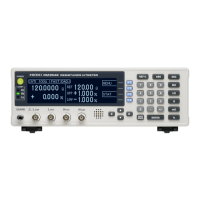6.4 Auto-Exporting Measured Values (at End of Measurement) (Data Output Function)
77
6
At the end of measurement, the measured value is exported to a computer via RS-232C.
See: "Chapter 9 Communications (RS-232C/ GP-IB Interface)" (p. 97)
6.4 Auto-Exporting Measured Values (at End of
Measurement) (Data Output Function)
• Set the interface to [RS232C] beforehand. This function is not applicable to the GP-IB Interface.
See:"9.4 Configuring the Communications Protocol" (p. 101)
• When internal (INT) triggering is selected, data is exported only when a TRIG signal is applied.
• Executing a
:READ? query command exports duplicate measured values.
• For other queries, be careful to avoid overlapping query response timing with auto-exporting measured val-
ues.
• The data format for measured values can be selected as ASCII (default) or BINARY. Transfer time is mini-
mized when BINARY is selected.
See:":SYSTem:FORMat <ASCii/ BINary>" (p. 137)
1
Open the Basic Settings screen.
2
Open the Data Memory Settings screen.
3
Enable or disable auto-exporting (DATA OUT)
4
Return to the Measurement screen.
The Basic Settings screen appears.
The Data Settings screen appears.
[DATA SETTINGS]
1
Selection
2
Selection
1
2
Disable auto-exporting (default)
Enable auto-exporting
The confirmation screen appears.
Return to the setting screen.
Save setting and return to
previous screen.
Discard setting and return to
previous screen.

